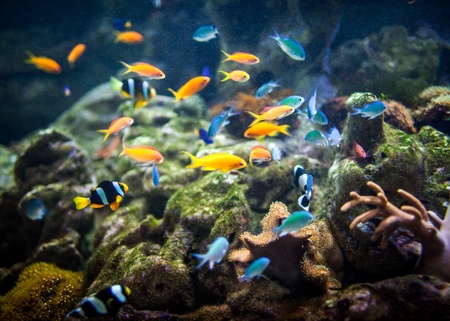Introduction to Community Aquariums
Community aquariums are a popular choice among aquarium enthusiasts across the United States. These tanks bring together a variety of fish and aquatic species that can coexist peacefully, offering hobbyists the opportunity to create vibrant, diverse underwater environments. The appeal of community aquariums lies in their dynamic appearance and the fascinating interactions between different species. Many hobbyists enjoy the challenge of selecting compatible tank mates, ensuring each fish thrives while contributing to the overall balance of the ecosystem. Not only do these multi-species setups provide an ever-changing display of color and behavior, but they also encourage responsible fishkeeping by requiring careful planning and maintenance. By understanding how different species interact, aquarists can prevent conflicts and promote a healthy environment for all inhabitants, making community tanks both rewarding and educational.
2. Understanding Tank Mate Compatibility
Choosing the right tank mates is one of the most crucial steps in maintaining a healthy community aquarium and preventing disease outbreaks. Not all fish species can coexist peacefully, and incompatible tank mates can lead to stress, aggression, or injury—each of which can weaken immune systems and open the door to illness. By understanding compatibility guidelines and risks, aquarists can create a thriving, low-stress environment that promotes better health for all inhabitants.
Why Compatibility Matters
Fish that are compatible tend to display natural behaviors, eat well, and have lower stress levels. Stress is a major contributor to disease in aquariums, as it suppresses the immune system and makes fish more susceptible to infections. Aggressive or territorial fish may chase or nip at others, causing wounds that are prone to bacterial or fungal infections. On the other hand, peaceful cohabitation supports overall well-being and reduces disease risk.
Typical Compatibility Guidelines
| Compatibility Factor | Recommendation |
|---|---|
| Size | Select fish of similar size to prevent predation or bullying. |
| Temperament | Group peaceful species together; avoid mixing aggressive with timid types. |
| Water Parameters | Choose species with overlapping needs for pH, temperature, and hardness. |
| Dietary Needs | Ensure all tank mates have compatible feeding habits and requirements. |
Common Compatible Community Fish Examples
- Tetras (Neon, Cardinal)
- Corydoras Catfish
- Guppies
- Mollies
- Zebra Danios
Potential Risks of Mixing Incompatible Tank Mates
- Aggression leading to fin damage or death
- Constant stress resulting in weakened immunity
- Bullied fish hiding excessively and missing out on food
- Disease transmission due to open wounds or suppressed health
Following established compatibility guidelines helps minimize these risks and is essential for both the happiness of your fish and the overall disease prevention strategy within your community aquarium.

3. How Tank Mate Choices Impact Disease Spread
When setting up a community aquarium, the fish species you choose to house together can significantly impact the likelihood and speed at which diseases spread throughout your tank. Selecting compatible tank mates isn’t just about avoiding fights; it’s a crucial factor in disease prevention and overall tank health.
The Role of Stress in Disease Transmission
Stress is one of the leading contributors to weakened immune systems in fish, making them more susceptible to illnesses. Aggressive or incompatible tank mates can cause constant stress, as fish may be chased, bullied, or outcompeted for food and hiding spaces. In these high-stress situations, pathogens like bacteria, parasites, and fungi have an easier time taking hold, increasing the risk of disease outbreaks that can quickly affect the entire aquarium.
Aggression and Physical Injury
Choosing tank mates that are prone to aggression or territorial disputes can result in physical injuries such as torn fins or open wounds. These injuries create entry points for infections and parasites, further exacerbating disease transmission. In contrast, peaceful species that coexist harmoniously are less likely to inflict such injuries, helping maintain a healthier environment for all inhabitants.
Species-Specific Disease Carriers
Certain fish species are natural carriers of specific diseases or parasites without showing symptoms themselves. If these species are introduced into a community tank with sensitive fish, they can unintentionally transmit pathogens even if they appear healthy. Proper research on compatibility and quarantine practices before introducing new tank mates is essential to limit this risk.
Ultimately, thoughtful selection of tank mates—focusing on compatibility in temperament, size, and environmental needs—not only reduces aggression and stress but also plays a direct role in minimizing the spread of diseases within your community aquarium.
4. Preventative Strategies for Disease Control
Keeping a healthy community aquarium involves more than just selecting compatible tank mates; it requires aquarists to take proactive steps in disease prevention. By integrating smart strategies into your routine, you can greatly reduce the risk of illness spreading among your fish. Here are some key preventative measures every aquarist should consider:
Quarantine Procedures
Quarantining new arrivals is one of the most effective ways to prevent introducing pathogens into your established tank. By isolating new fish for at least two weeks, you give them time to acclimate and allow potential diseases to manifest before they can affect your main community. This also applies to new plants or invertebrates that could harbor parasites or bacteria.
Routine Maintenance
Regular tank maintenance is essential for disease control. This includes partial water changes, cleaning the substrate, checking and maintaining filtration systems, and monitoring water parameters. Consistent upkeep prevents harmful waste buildup and supports a stable environment where beneficial bacteria thrive.
| Maintenance Task | Frequency |
|---|---|
| Partial Water Change (20-30%) | Weekly |
| Filter Cleaning | Monthly |
| Gravel Vacuuming | Biweekly |
| Water Parameter Testing | Weekly |
Proper Feeding Practices
Overfeeding is a common mistake that leads to poor water quality and increases disease risks. Feed only what your fish can consume within a few minutes and remove uneaten food promptly. Choose high-quality, species-appropriate foods to support robust immune systems and overall health.
Regular Observation
Spend time observing your aquarium daily. Look for behavioral changes, signs of stress, discoloration, or unusual spots on your fish. Early detection allows you to address issues before they escalate and affect the entire community.
The Takeaway
By adopting these preventative strategies—quarantine, routine maintenance, proper feeding, and vigilant observation—you create a healthier habitat for all tank mates and dramatically reduce the likelihood of disease outbreaks in your community aquarium.
5. Recognizing and Managing Disease Outbreaks
Identifying Signs of Illness in Your Community Aquarium
Spotting disease early is crucial for maintaining a healthy community aquarium. Common signs of illness include changes in swimming behavior, loss of appetite, visible spots or lesions, clamped fins, excessive hiding, rapid gill movement, and discoloration. Its important to observe your tank regularly so you can quickly identify anything out of the ordinary with your fish or invertebrates.
Steps for Isolating Sick Fish
If you notice a potentially sick tank mate, the first step is to isolate them in a separate hospital or quarantine tank. This helps prevent the spread of disease to healthy fish. Make sure the isolation tank has similar water parameters to reduce stress on the sick fish. Using dedicated equipment for the quarantine tank—like nets and siphons—can also limit cross-contamination between tanks.
Treatment Options Available
Treatments vary depending on the illness. Over-the-counter medications can address common issues like ich (white spot disease), fin rot, or fungal infections. Salt baths and temperature adjustments are sometimes recommended for mild cases. Always follow product instructions carefully and avoid overmedicating, as this can harm both sick and healthy tank mates.
Natural Remedies vs. Commercial Medications
Some aquarists prefer natural treatments such as garlic-soaked foods or herbal remedies, especially for minor ailments. However, serious outbreaks often require commercial medications for effective results. Research each option thoroughly and consider how different treatments might affect your specific tank inhabitants.
When to Seek Help from Aquatic Vets or Experts
If symptoms persist despite treatment efforts or if you’re unsure about the diagnosis, it’s time to consult an aquatic veterinarian or experienced aquarium professional. They can provide advanced diagnostic tests, recommend targeted medications, and offer guidance tailored to your unique tank setup. In many U.S. cities, specialized aquatic vets are accessible either locally or through telehealth services.
The Importance of Early Intervention
Prompt action not only saves individual fish but also protects the overall health of your community aquarium by minimizing stress and preventing widespread outbreaks among tank mates. Staying vigilant and proactive is key to enjoying a thriving aquatic environment.
6. Building a Healthy Community Tank Culture
Creating a healthy community aquarium goes beyond just picking compatible fish—it’s about fostering an environment where every tank mate can thrive, reducing the risk of disease outbreaks. First, always research the specific needs of each species you plan to keep, including their preferred water parameters, dietary requirements, and social behaviors. When you select tank mates that share similar environmental needs and temperaments, you minimize stress, which is a major factor in disease susceptibility.
Establishing a consistent tank maintenance routine is key to supporting overall health. Regularly test water quality for ammonia, nitrite, nitrate, and pH levels, and perform partial water changes to keep conditions stable. Use a high-quality filtration system that suits the size of your tank and its bioload. Quarantine new arrivals before introducing them to your community tank—this simple step can prevent pathogens from spreading among your established fish.
Feeding is another critical aspect. Offer a balanced diet tailored to the nutritional needs of your tank inhabitants, and avoid overfeeding to reduce waste buildup and water contamination. Observe your fish daily for signs of stress or illness—early detection is vital for effective treatment and limiting the spread of disease within the community.
Promote natural behaviors by providing hiding spots with plants, rocks, or decorations. A well-structured habitat reduces aggression and allows timid fish places to retreat, lowering stress across the tank. Maintaining proper stocking levels also helps; overcrowding leads to competition and weakened immune systems, while understocking can make some species anxious or territorial.
Ultimately, building a healthy community tank culture relies on careful planning, consistent care, and attentive observation. By creating a balanced ecosystem where each species can flourish together, you not only enjoy a more vibrant and active aquarium but also significantly decrease the chances of disease taking hold among your aquatic pets.


